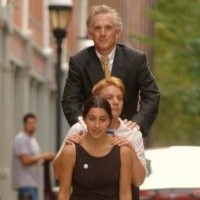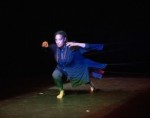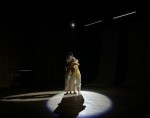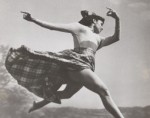
Lots of Glitter, Few Stars
by Jonathan Stein
In this season of Nutcrackers, feuding Republicans, and holiday kitsch, the Annenberg’s Dance Celebration Series brought us “Champions of the Dance.” Despite the glittering costumes and exacting, stylized ballroom dancing routines, the evening was mostly a yawn.Milking the television audience success of ABC’s Dancing with the Stars and BBC’s Strictly Come Dancing, this touring production brings together a dozen ballroom dance competition winners led by Jonathan Roberts and his wife and dance partner, Anna Trebunskaya. Roberts, a former US and World American Smooth Champion, coached and choreographed for the TV shows So You Think You Can Dance, and Dancing with the Stars. Russian-born Trebunskaya has been paired with celebrities in eight seasons of the competitive Stars show.
Most of the dancers came from the former Soviet Union, where Communist governments had subsidized “DanceSport” (Latin and International Style competition ballroom dancing, broadcast on U.S. television since 1960). Its adherents immigrated here in the 90s as ballroom teachers and, building on the Arthur Murray precedents, expanded a dance competition industry that, according to author Juliet McMains, consciously confused and conflated distinctions between social and competitive dancing. The result was a “codification of social dancing into a saleable product.” (See McMains’ Glamour Addiction: Inside the American Ballroom Dance Industry.)
The resulting competition tropes of overblown movement and gesture predominated with a corresponding lack of musicality in the bodies of the dancers. Posturing substituted for dancing, and, with rare exceptions, ubiquitous, non-stop smiling was vapid and joyless.
Latin numbers, which alternated with “European” ones, emphasized exaggerated hip movements, but neglected the torso and nuances usually associated with Latin dance forms. A tango by Randy Dias and Viktorija Barasihina got the timing and steps right, but there was no sensuality in their bodies. The men’s bronzing make-up, standard for this esthetic, turned me off as racial stereotyping for the “Latin” look.
The few satisfying duets featured Trebunskaya. She projects theatrical dazzle worthy of a good Broadway musical, especially as she is set off by the far-less charismatic presence of Roberts, her partner/husband. (See some of her YouTube Dancing with the Stars videos.) Their open-style Viennese waltz to Christina Aguilera’s “You Lost Me” was a fun, cheesy and expressive take on the song (“…our world’s been infected/And somehow you left me neglected”). To “I’m a Woman” by Melinda Doolittle, this glamorous Russian redhead with a radiant smile the width of, say, a ballroom, vamps as the W-O-M-A-N who can “feed the baby, grease the car, & powder my face at the same time.”
As someone who has been on the dance floor, but mostly as a contact improviser, I assembled my own TD judging team: my daughter, who has competed as a ballroom dancer and a friend with stellar social dance chops. For most of the two dozen duets on the “Champions” program, we applauded dedication and effort, but voted to send the champs back to the minors, or the next TV competition series. Through their mixed response on opening night many in the large audience seemed to concur.
“Champions” used snippets of Hollywood dance films as segues into some routines. Not credited, these included bits with Fred Astaire and Rita Hayworth, possibly from So Near and Yet So Far; Richard Gere and Jennifer Lopez in Shall We Dance; and Patrick Swayze and Jennifer Grey in Dirty Dancing. The all-too-brief interludes added little except a desire to see these films in lieu of what was live on stage.
The evening ended with a swing class (“side-side-rock step”) taught by performers in the lobby. Audience members lined up to take this lesson with the “stars.” Our team was left with the conundrum: should social dancing ever be “staged” and is its vitality undone by its commodification, however popular, on TV or packaged as concert dance?
“Champions of the Dance,” Annenberg Center, Dec. 15-18, 2011. No further performances.
By Jonathan Stein
December 21, 2011









